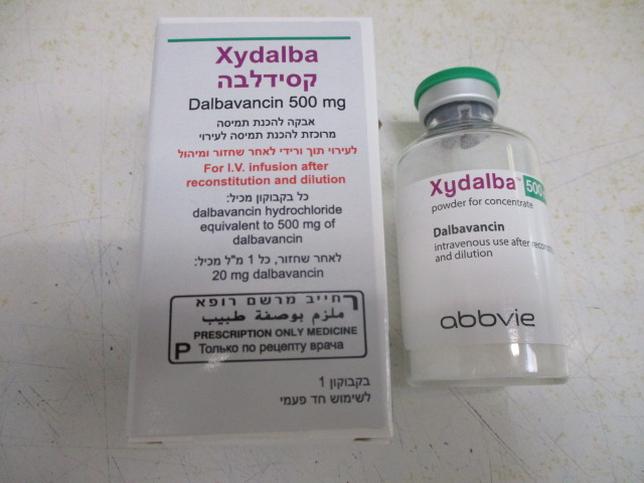Quest for the right Drug

קסידלבה XYDALBA (DALBAVANCIN)
תרופה במרשם
תרופה בסל
נרקוטיקה
ציטוטוקסיקה
צורת מתן:
תוך-ורידי : I.V
צורת מינון:
אבקה להכנת תמיסה מרוכזת לעירוי : POWDER FOR CONCENTRATE FOR SOLUTION FOR INFUSION
עלון לרופא
מינוניםPosology התוויות
Indications תופעות לוואי
Adverse reactions התוויות נגד
Contraindications אינטראקציות
Interactions מינון יתר
Overdose הריון/הנקה
Pregnancy & Lactation אוכלוסיות מיוחדות
Special populations תכונות פרמקולוגיות
Pharmacological properties מידע רוקחי
Pharmaceutical particulars אזהרת שימוש
Special Warning עלון לרופא
Physicians Leaflet
Adverse reactions : תופעות לוואי
4.8 Undesirable effects Summary of the safety profile In Phase 2 / 3 clinical studies, 2,473 patients received dalbavancin administered as either a single infusion of 1,500 mg or as 1,000 mg followed one week later by 500 mg. The most common adverse reactions occurring in ≥ 1 % of patients treated with dalbavancin were nausea (2.4 %), diarrhoea (1.9 %), and headache (1.3 %) and were generally of mild or moderate severity. Tabulated list of adverse reactions (Table 1) The following adverse reactions have been identified in Phase 2/3 clinical trials with dalbavancin. Adverse reactions are classified according to System Organ Class and frequency. Frequency categories are derived according to the following conventions: very common (≥ 1/10), common (≥ 1/100 to < 1/10), uncommon (≥ 1/1,000 to < 1/100), rare (≥ 1/10,000 to < 1/1,000). Table 1 System Organ Class Common Uncommon Rare Infections and vulvovaginal mycotic infection, infestations urinary tract infection, fungal infection, Clostridioides (formerly Clostridium) difficile colitis, oral candidiasis Blood and lymphatic anaemia, thrombocytosis, system disorders eosinophilia, leucopenia, neutropenia Immune system anaphylactoid disorders reaction Metabolism and decreased appetite nutrition disorders Psychiatric disorders Insomnia Nervous system headache dysgeusia, dizziness disorders Vascular disorders flushing, phlebitis Respiratory, thoracic Cough bronchospasm and mediastinal disorders Gastrointestinal nausea, constipation, abdominal pain, disorders diarrhoea, dyspepsia, abdominal discomfort, vomiting Skin and subcutaneous pruritus, urticaria, rash tissue disorders Reproductive system vulvovaginal pruritus and breast disorders General disorders and infusion-related reactions administration site conditions Investigations blood lactate dehydrogenase increased, alanine aminotransferase increased, aspartate aminotransferase increased, blood uric acid increased, liver function test abnormal, transaminases increased, blood alkaline phosphatase increased, platelet count increased, body temperature increased, hepatic enzyme increased, gamma-glutamyl System Organ Class Common Uncommon Rare transferase increased, Description of selected adverse reactions Class adverse reactions Ototoxicity has been associated with glycopeptide use (vancomycin and teicoplanin); patients who are receiving concomitant therapy with an ototoxic medicinal product, such as an aminoglycoside, may be at increased risk. Reporting of suspected adverse reactions Reporting suspected adverse reactions after authorisation of the medicinal product is important. It allows continued monitoring of the benefit/risk balance of the medicinal product. Any suspected adverse events should be reported to the Ministry of Health according to the National Regulation by using an online form https://sideeffects.health.gov.il/ In addition, you may report suspected adverse reactions by sending an e-mail message to safety@tzamal-medical.co.il

שימוש לפי פנקס קופ''ח כללית 1994
לא צוין
תאריך הכללה מקורי בסל
לא צוין
הגבלות
לא צוין
מידע נוסף
